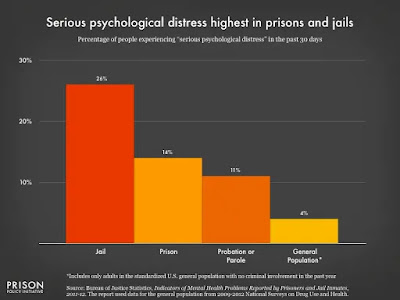When thinking about prison, what do you think is its primary goal? Many people fantasize about it being a place for rehabilitation. Unfortunately, in the United States, most of the time this isn't the case. Now, this is not because prisoners are not willing, but because of the harmful impacts our current prison system can have on a person's brain. Unfortunately, over the years the negative effects of incarceration have only continued to increase.
 |
| Source |
Our current prison system makes rehabilitation challenging because those who are imprisoned are subjected to conditions that can cause negative cognitive effects, which can make adjusting to post-prison life extremely difficult. One example of this is that while incarcerated people can become so dependent on relying on someone else's rules or schedule, that it becomes very difficult for them to adjust to life once they are no longer in prison. Additionally, prison can be an extremely scary place. This can result in people exhibiting behavioral changes. Some prisoners feel that they need to become more aggressive in order to feel protected in a prison environment. Being incarcerated is also extremely stressful, which can cause some people in prison to become isolated from others and make them feel that they can't trust anyone. The process of imprisonment can be so mentally challenging that it can trigger traumatic memories, that may result in post-traumatic stress reactions.
 |
| Percentage of People Experiencing Serious Psychological Distress in Jails vs General Population Source |
These negative psychological effects only get worse when prisoners are exposed to solitary confinement. Unfortunately, the use of solitary confinement is not heavily regulated and is often at the discretion of those in charge of the prison. Additionally, many who are placed in solitary confinement are in jail for nonviolent offenses. The use of solitary confinement can have extremely detrimental effects on a person's overall health. Solitary confinement deprives inmates of their basic social needs, which results in a vast amount of negative psychological consequences. Some examples include hypersensitivity, paranoia, hallucinations, aggression, depression, and anxiety. All of these things will continue to harm a person mentally even after being released from solitary confinement or prison in general, making it even more difficult for them to adjust to life post-prison. From a neuroscience perspective, social pain can be just as detrimental as physical pain, as there is evidence that social pains, such as that extreme isolation, have overlapping brain activity patterns with physical pain. It is hypothesized that this is an evolutionary adaptation because of how reliant humans and other mammals are for maternal care in the earlier parts of their life. The experience of pain during social separation would alert the mammal that something needed to be done, to prevent them from being harmed by the maternal separation.
There are many misconceptions about the use of neuroscience in the world of criminal justice. There are some areas where it can be extremely helpful, while in other areas not so much. TV shows and movies often present an unrealistic expectation of how neuroscientific assessments can be used in courts. EEGs, which measure the electrical activity of the brain, are not able to differentiate between if a person engaged in criminal activities or if they are simply lying, which is a common antisocial behavior. Additionally, misconceptions about neuroscience assessments can result in the assessments swaying juries, even if they did not display relevant evidence. The use of neuroscience in courts also adds another layer of economic discrimination, which is already a very prevalent issue in the judicial process. Brain scans are very costly and their ability to persuade juries on the basis of pseudoscience creates an unjust advantage for the wealthy. However, neuroscience can be extremely useful in terms of reforming the current prison system. In the United States, around 1/5 of incarcerated adults suffer from serious mental illness. Currently, treatment for these mental illness are not tailored specifically to the illness, which can make prisoner's symptoms worse. Strategies based on neuroscience could help make treatment more specific to the illness. Neuroscience can also be helpful when discussing the overpopulation of prisons. The overcrowding of prisons creates an environment that increases stress levels, which can negatively impact the regions of the brain that deal with emotions and behavioral control.
 |
| Rate of Serious Mental Illness in Regular Population and Jail Population Source |
I've read a lot about the social benefits of countries implementing actual rehabilitation programs, it'd be really interesting to see what impact that would have on the brain
ReplyDeleteThis is the sad truth about our prison system. It does more damage than good. I loved how you were able to outline various conditions in prison and then explain the possible effect it would have on the prisoner.
ReplyDelete